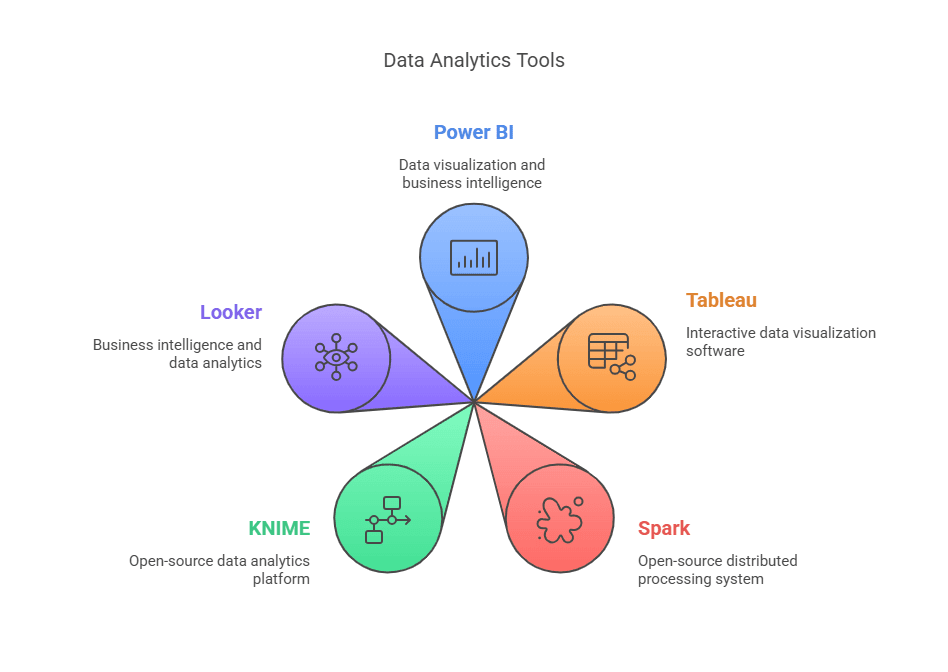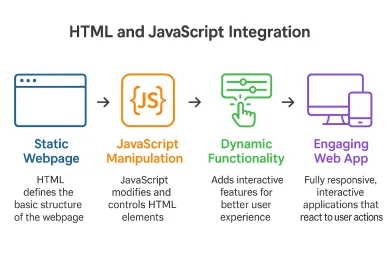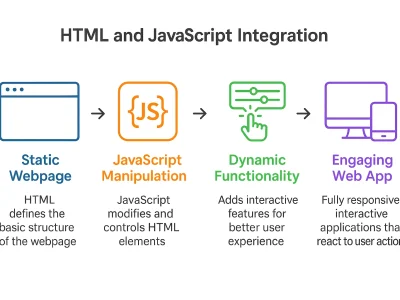Introduction
This ensures that your skills are always up to date, which is vital in an ever-evolving field like data analytics. With the advent of an increasingly data-driven world, organizations need skilled analysts who can harness these data analytics tools to extract insights from vast sets of data. Knowing which tools to learn for a competitive advantage in 2025 is key, whether you are a novice or a seasoned professional. This article explores some of the most popular data analytics tools, their key features, use cases, learning resources, and emerging trends in the field.

Microsoft Power BI
Overview
Microsoft Power BI is a top advanced business analytics tool that is designed to offer interactive visualization and business intelligence capabilities. It’s part of the Microsoft Power Platform and is widely used by professionals in multiple industries to analyse and report on data.
Key Features
- Data Connection: Connects to data from a variety of sources like Excel, SQL Server, and cloud services
- Data Modelling: Provides enhanced data modelling functions for building personalized reports.
- Real-Time Analytics: Provides real-time data analysis for informed decision-making.
- Interactive Visuals: Enable users to build interactive reports and dashboards quickly.
Use Cases
- Business Dashboards: Measure KPIS and evaluate business performance.
- Reporting: Create reports for key stakeholders across various departments.
- Data Transformation: Make ETL easier, which involves Extract, Transform, Load (ETL) processes for seamless data analysis.
Learning Resources
- Official Power BI Documentation by Microsoft
- Free online courses are available on Coursera, Udemy , and LinkedIn Learning.
- Additionally, it covers new hands-on learning paths provided through Microsoft Learn.
Tableau
Overview
Tableau is a potent yet simple data visualization tool that can convert raw data into insight using interactive visualizations. Fast and user-friendly, it is extensively used by businesses for data exploration and storytelling.
Key Features
- It has a drag-and-drop interface: This feature allows users to build complicated visualizations without knowing any code.
- Also Available = Advanced Analytics (predictive analytics and trend analysis tools);
- Collaboration Tools: Enables teams to share dashboards and reports.
- Cross-Platform Integration: Multiple Data Sources including Google Analytics, SQL, etc.
Use Cases
- Business Intelligence: Monitor business KPIS via interactive dashboards.
- Customer Behaviour: Use Data to Improve Marketing.
- Business Intelligence: Monitor business health and key metrics.
Learning Resources
- Official Tableau training and tutorials.
- Tableau Community for peer-to-peer help.
- Available on platforms like Coursera, LinkedIn Learning, and Udemy.
Apache Spark
Overview
Apache Spark is an open-source distributed computing system that is fast and scalable. It is commonly employed for big data processing, real-time analytics, and machine learning. For organizations working with large datasets, Apache Spark is indeed a fundamental tool.
Key Features
- Real-Time Processing: Processes streaming data in real-time for immediate insights.
- Fault Tolerance: More importantly, even in the event of a system failure, data can still be processed.
- Integration with Machine Learning: Utilises MLlib to create scalable machine learning models.
- Scalability in the Data: Setting horizontal scaling allows huge datasets to be exported efficiently.
Use Cases
- Big Data Processing : The process of analysing large datasets in very short time intervals.
- Automated Machine Learning: Train large-scale machine learning models.
- Processing live data for on-demand scrutiny, Real-Time Analytics
Learning Resources
- Official Apache Spark Documentation and Tutorials
- Take massive open online courses (MOOCS) for free through DataCamp, Coursera, and Udemy.
- The ever-helpful YouTube, which goes further by offering tutorials.
KNIME
Overview
KNIME is an open-source analytics platform for building data workflows, from data transformation and analysis to machine learning. The user-friendly interface makes it ideal for both novices and seasoned experts.
Key Features
- Design Visual Workflow: Create data analysis workflows in the UI.
- (Including: Extensibility: Offers many plugins for customized workflows.)
- Advanced Analytics: Consists of machine learning, text mining, and statistical analysis tools.
- Integration: The ability to connect with various data sources and other tools.
Use Cases
- Data Mining: Uncover patterns in large data sets.
- Prescriptive Analytics: Guided the actions to take.
- You are taught with data until October 2023.
Learning Resources
- KNIME Academy Free Online Training Courses
- Community-maintained guides such as wikis and forums;
- Free videos on YouTube or educational platforms like LinkedIn Learning.
RapidMiner
Overview
RapidMiner is a data science platform for preparation, model building, and deployment. Bayesian methods are widely used in machine learning and predictive analytics, offering both no-code and code-based solutions.
Key Features
- No Code: Build models with no coding required.
- Some of these trends are as follows: Automated Machine Learning (AutoML): Helps the users make the machine learning process easier.
- Data Preparation Tools: Integrated tools for data cleansing, data transformation, and data visualization.
- These include: a Wide Range of algorithms, a wide variety of machine learning algorithms, and statistical models.
Use Cases
- Predictive analytics – Identify: Use past data throughout the processes to predict future trends.
- Customer Segmentation: To target a specific group of consumers more effectively
- Unusual Pattern Recognition: Identify the outliers in the data to detect fraud or error.
Learning Resources
- RapidMiner Academy offers free courses for both beginner and advanced users.
- Free ops can be found through YouTube and DataCamp tutorials.
- Official RapidMiner tutorials and webinars.
Looker
Overview
Perhaps the purpose of the You are a data only business intelligence stage you can instantly adapt, heap up and assemble the insight of one’s distribution center on the You are a file based business intelligence google You transport data pundits You are pictorial You are houses and analysts that you are customarily outfitted to do with it. This one is known for its customizable dashboards and reports.
Key Features
- Level: LookML Modelling Language: User-defined data models.
- Real-Time Analytics: Enable analysis of data as it comes in, allowing for data-driven decisions right away.
- Collaboration – Share dashboards and reports across teams swiftly.
- Data Exploration: Provide users with an intuitive interface for interactively exploring data.
Use Cases
- Business Intelligence Reporting: Making Informed Decisions.
- Data Exploration: Uncover insights from vast datasets.
- Sales & Marketing Analytics: To track and improve marketing campaigns and sales performance
Learning Resources
- Looker official docs/training portal.
- Free tutorials are available online to learn coding.
QlikView
Overview
QlikView enables users to explore data using associative visualizations and is a product from QlikTech, a light-weight, interactive dashboard which organizations can use to make their decisions.
Key Features
- Associative Data Model: The user can perform analytics on data from multiple sources simultaneously.
- In-Memory Technology – It processes a massive amount of data in memory and provides fast analytics.
- Customized Dashboards: Users have the option to create dashboards based on custom business needs.
Use Cases
- Sales Analytics: Track and optimize sales strategies and performance.
- Operational Reporting. Operational Reporting: Reports are generated to monitor and manage business operations.
- Financial Reports: Build financial dashboards for quick insights
Learning Resources
- Support for QlikView-powered Android and ios devices
- Online troubleshooting tutorials and forums.
- Engage with your peers and learn from others about the Qlik Community.
Zoho Analytics
Overview
Cloud-based business intelligence/analytics tool for small to medium-sized businesses which allows users to easily create reports, dashboards, and data visualizations.
Key Features
- Data Blending: Combines data from different sources, like spreadsheets and cloud apps.
- We can create dashboards for data analysis.
- Collaboration Tools: Foster team collaboration and share reports instantly.
Use Cases
- Financial Analytics: Expense, Revenue, and Profit Tracking.
- Business Intelligence Use customized reports and visualizations to make data-driven decisions.
- Customer insights: Leverage customer data for improved targeting
Learning Resources
- Article Technical Documentations Zoho Analytics Help Articles
- To review some key points: Community resources are available on forums and YouTube.
- Training films from Zoho.
Google Data Studio
Overview
Google Data Studio is a free, versatile reporting and dashboard-building tool from Google. It’s fully integrated with Google products, such as Google Analytics and Google Ads.
Key Features
- Seamless Integration: Connects easily to Google Analytics, Google Ads, and Google Sheets.
- Never Miss a Beat: Data flows in real-time for accurate reporting.
- Interactive Reports: Enables users to build dynamic reports and dashboards.
- Collaborative Capabilities: Deliver reports in real-time to your teams and stakeholders.
Use Cases
- SEO Analytics: Monitor website and SEO performance.
- There are marketing reports that track the performance of the digital marketing campaigns.
- Operational Dashboards: Create live dashboards for operational insight.
Learning Resources
- Official Google Data Studio Help Centre for tutorials and Documentation
- Free courses, such as those on Coursera and LinkedIn Learning.
- Community efforts tutorial on YouTube.
SAS
Overview
SAS (Statistical Analysis System) is a powerful analytical platform for managing data, conducting statistical analysis, and performing predictive analytics. It has become increasingly popular in sectors such as healthcare, finance, and retail.
Key Features
- Business Intelligence: Seamlessly integrates with BI tools and dashboards.
- Brokering Data: Assists in handling large datasets efficiently.
- Hadoop Integration: Integrates seamlessly with big data platforms like Hadoop
- Security: High standards of security are a hallmark of data analysis.
Use Cases
- Healthcare Analytics, Predictive modelling, patient care optimization
- Credit card fraud and risk management: Financial Services
- Retail Analytics is used for sales forecasting and inventory management
Learning Resources
- SAS Basics Tutorials and Certifications
- EdX and Coursera are offering free online courses
- Search the SAS Community for troubleshooting issues and learning
Emerging Trends in Data Analytics Tools
With 2025 approaching, there are several trends we can expect to see shaping the future of the data analytics tools space:
Integration of Artificial Intelligence and Machine Learning
More AI and ML integration in data analytics tools will automate data analysis tasks and provide predictive insights. Tools such as RapidMiner and KNIME have already begun embedding machine learning models to augment data exploration.
Emphasis on real-time data processing
In addition, as businesses are looking to get decisioning faster, tools, such as Apache Spark and Power BI, are getting better at real-time data processing. These trends enable faster decision-making and action based on live data.
Growing importance of data privacy and security features
As data privacy concerns rise, analytics tools are focusing more on security features. Enhanced Security SAS, QlikView, and other tools provide enhanced security features to comply with regulations such as GDPR.
How to Choose the Right Tool for Your Needs
Some pointers to consider when assessing organisational requirements when picking a data analytics tool.
Evaluating Enterprise Needs: Deciding which tool is best for your organization is based on understanding your organization’s needs. Do you need real-time analytics? Excellent machine learning capabilities? Or maybe just simple data visualization?
Considering the learning curve and available training: Some tools have a high learning curve, but others, such as Power BI and Google Data Studio, are easier to get started with for beginners. Ensure that you have the necessary resources and time dedicated to learning the tool.
Evaluating cost versus benefit: Cost will always be an important consideration. Consider how much the tool will cost versus what benefits it can offer your organization. Some tools are free (Google Data Studio and KNIME), and some tools need paid licenses (e.g., Tableau and Power BI).
Conclusion
The right analytics tools to master for career growth in 2025 in today’s fast-evolving data-driven world. And frankly, whichever of the Power BI, Tableau, or any of the other tools on this list you select, keeping up with the latest technologies will always give you a competitive edge. Pick and learn tools that match your career goals and the organization’s requirements.
Explore the tools mentioned in this article and their associated learning resources to stay ahead in your data analytics career. To recap, the Data analytics domain is evolving, and new tools are emerging that unlock future opportunities.
For more information, visit TuteDude’s Data Analytics section.




